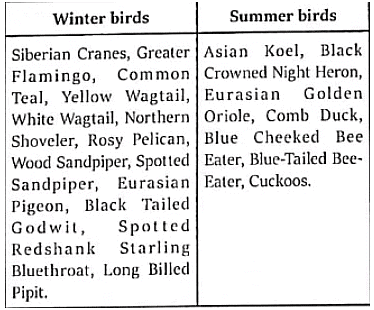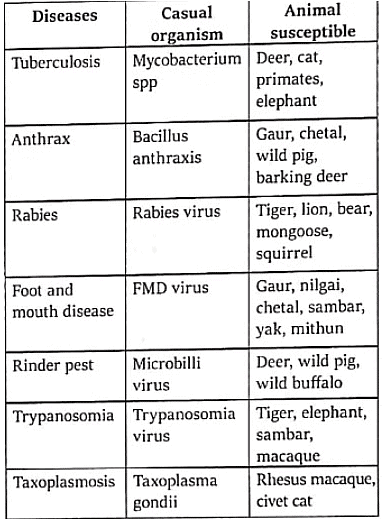Shankar IAS Summary: Animal Diversity of India - 3 | Famous Books for UPSC Exam (Summary & Tests) PDF Download
| Table of contents |

|
| Coral |

|
| Bird’s Migration |

|
| Wildlife Diseases |

|
| Species Extinction |

|
| Man - Animal Conflict |

|
| Advisory for Managament of Human-Wildlife Conflict (HWC) |

|
Coral
Fire corals
Fire corals (Milleporidae) are marine organisms that belong to the hydrozoan class, and they are more closely related to jellyfish than true corals. Here are some key points about fire corals:
- Sensation on Contact: When in contact with fire corals, individuals typically experience a burning sensation, similar to the sting from a jellyfish. It is essential to handle them with care to avoid these stings.
- Habitat: Fire corals are generally found in murky inshore waters. They display a certain level of tolerance for siltation, making them adaptable to a range of environmental conditions. Despite their presence in inshore waters, they can also be found in clear offshore sites.
- Distribution: The distribution of fire corals includes regions such as Indonesia, the Gulf of Chiriqui in Panama, and the Pacific Province. However, there are indications that they may have become extinct in certain areas, including Australia, India, Indonesia, Malaysia, Panama, Singapore, and Thailand.
- Threats: One significant threat to fire corals is their collection for decoration and the jewelry trade. The demand for these organisms in the trade industry poses a risk to their populations. Additionally, fire corals are sensitive to temperature changes. The effects of global warming, including rising sea temperatures, have led to bleaching events in coral reefs. This sensitivity to temperature rise may have contributed to the disappearance of fire corals from many marine areas.
- Status: There are concerns that fire corals may have completely disappeared from the majority of marine areas due to the combined effects of human activities such as collection and the impacts of climate change, particularly global warming-related bleaching.
 Fire Corals
Fire Corals
Understanding the threats and vulnerabilities of fire corals is crucial for conservation efforts to protect these marine organisms and the ecosystems they inhabit.
Are black rhinos really black?
No, black rhinos are not black at all. The species probably derives its name as a distinction from the white rhino (which is not white at all either) or from the dark-colored local soil that often covers its skin after wallowing in mud.
Bird’s Migration
Migration refers to the regular, recurrent, and cyclical seasonal movement of birds from one place to another. The distance of migration ranges from short distances to thousands of kilometers. However, at the end of the period, birds will eventually return to the original place.
Reasons for migration:
- To avoid adverse factors (extreme climatic conditions).
- To manage food shortages.
- To manage shortages of water.
- To have better breeding conditions.
- Less competition for safe nesting places.
 Migratory Birds
Migratory Birds
Wildlife Diseases
 Disease caused by different animals
Disease caused by different animals
Do you know?
All birds have feathers and feathers do many jobs for birds. It keeps them warm, wing feathers allow flight and tail feathers are used for steering. The color of the feathers can be used to hide the bird or to help the bird find a mate.
Species Extinction
Extinction is caused through various processes:
Deterministic processes: These have a cause and effect, including glaciations and human interference like deforestation.
Stochastic processes: Involving chance and random events affecting survival and reproduction. Examples include unexpected weather changes, decreased food supply, diseases, and an increase in competitors, predators, or parasites. These may act independently or add to deterministic effects.
The impact of these processes depends on the size and degree of genetic diversity and resilience of populations.
 Shabro thothed tiger
Shabro thothed tiger
Traits that increase a species' vulnerability to extinction due to habitat fragmentation include:
- Rarity or low abundance.
- Poor dispersal ability.
- Ecological specialization.
- Unstable populations.
- High trophic status, as animals occupying higher trophic levels usually have smaller populations.
- Low adult survival rates.
- Low intrinsic rate of population increase.
Factors such as body size, fecundity, and dietary specialization also play a role.
Natural extinctions:
- Caused by factors like continent drifting, climate change, tectonic activity, increased volcanic activity.
- Examples include the late Ordovician global glaciations (439 Mya) and the late Cretaceous extinction associated with an extra-terrestrial impact.
- Extinction in vascular plants has been more gradual, often due to competitive displacement or gradual climate change.
 Megalodon
Megalodon
Artificial Extinction:
- While species extinction is a natural process, human-caused extinctions are now happening at rates exceeding natural estimates.
- Threats include direct causes like hunting, collection, capture, and persecution.
- Indirect causes involve habitat loss, modification, fragmentation, and the introduction of invasive species.
Understanding these factors is crucial for conservation efforts to mitigate the impact of human activities on biodiversity and prevent further species loss.
Man - Animal Conflict
It refers to the interaction between wild animals and people and the resultant negative impact on people or their resources, or wild animals or their habitat. It occurs when wildlife needs overlap with those of human populations, creating costs to residents and wild animals.
Causes:
- Human population growth
- Land use transformation
- Species habitat fragmentation, loss, degradation
- Increasing livestock populations and competitive exclusion of wild herbivores
- Growing interest in ecotourism and increasing access to nature reserves
- Abundance and distribution of wild prey
- Increasing wildlife population as a result of conservation programs
- Climatic factors
- Stochastic events (e.g., fire)
Impacts:
- Crop damage
- Livestock depredation
- Injuries to people
- Loss of human life
- Damage to property
- Injuries to wildlife
- Animal deaths
- Destruction of habitat
Preventive strategies:
- Artificial and natural barriers (physical and biological)
- Guarding
- Alternative high-cost livestock husbandry practices
- Relocation: voluntary human population resettlement
- Waste management systems that restrict wildlife access to refuse
Mitigative strategies:
- Compensation systems
- Insurance programs
- Incentive programs
- Community-based natural resource management schemes (CBNRMS)
- Regulated harvest
- Increase alternative crops, preys, or water points
- Wildlife translocation
- Conservation education for local populations
- Better sharing of information.
Do you know?
Black Panther is not a separate species. Blackness, the general darkening of colour is due to the excessive presence of a substance called Melanin which intensifies pigmentation. The production of melanin is increased where there is a combination of high temperature, humidity and reduced light. Both black and normal-coloured cubs may be produced in the same litter.
Advisory for Managament of Human-Wildlife Conflict (HWC)
The advisory makes prescriptions for the States/Union Territories for dealing with Human-Wildlife conflict situations and seeks expedited inter-departmental coordinated actions, adoption of early warning systems, creation of barriers, dedicated circle-wise Control Rooms with toll-free hotline numbers, Identification of hotspots, and formulation and implementation of special plans for improved stall-fed farm animals, etc.
The advisory envisages empowering gram panchayats in dealing with the problematic wild animals as per the section 11 (1) (b) of Wild Life (Protection) Act, 1972.
Payment of a portion of ex-gratia as interim relief within 24 hours of the incident to the victim/family.
Utilizing add-on coverage under the Pradhan Mantri Fasal Bima Yojna for crop compensation against crop damage due to HWC and augmenting fodder and water sources within the forest areas are some key steps envisaged to reduce HWC.
|
744 videos|1444 docs|633 tests
|
FAQs on Shankar IAS Summary: Animal Diversity of India - 3 - Famous Books for UPSC Exam (Summary & Tests)
| 1. What is coral? |  |
| 2. How do birds migrate? |  |
| 3. What are wildlife diseases? |  |
| 4. Why is species extinction a concern? |  |
| 5. What is human-wildlife conflict? |  |




















